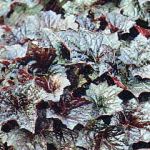| Common Name: |
American Sanicle |
| Other Names: |
Alumroot |
| Botanical Name: |
Heuchera americana |
| Genus: |
Heuchera |
| Family: |
Saxifragaceae |
| Native Location: |
Central and Eastern N America |
| Cultivation: |
Moist, well-drained, neutral soil in sun or partial shade. Shoots may be distorted by leafy gall; leaf nematodes may damage leaves. |
| Propagation: |
By seed sown in spring; by division in autumn |
| Harvest: |
Roots are lifted in autumn and dried for decoctions and powders. |
| Height: |
45cm (18in) |
| Width: |
30cm (12in) |
| Hardiness: |
Z4-9 |
| Parts Used: |
Roots |
| Properties: |
A bitter, astringent herb that controls bleeding and discharge, and promotes healing. |
| Medicinal Uses: |
Internally for diarrhea, dysentery, and gastric ulcers. Excess irritates the stomach and causes kidney and liver failure. Externally for sores, wounds, sore throat, and vaginal discharge. |
| Bibliography: |
The Encyclopedia of Herbs by Deni Bown Copyright © 1995, 2001 Dorling Kindersley Limited. pp. 234-235 |

